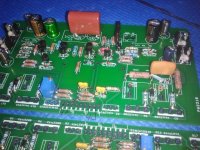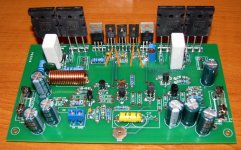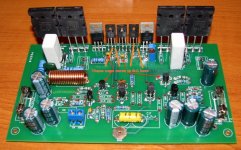I haven't looked closely, but there is an 'old' and a 'new' right on Harrison's website. Just as an aside, I practically built mine with 'on-hand' junk box parts. I did not follow a BOM per-se.
After I found and rectified an error I brought upon myself (outlined in this thread) they seemed to work just fine. Again, the v2 boards. Another member (IIRC Tekko), who I believe is no longer active here (banned), had oscillations and made the compensation changes. To the best of my knowledge he got his to work.
After I found and rectified an error I brought upon myself (outlined in this thread) they seemed to work just fine. Again, the v2 boards. Another member (IIRC Tekko), who I believe is no longer active here (banned), had oscillations and made the compensation changes. To the best of my knowledge he got his to work.
The decoupling in the same location on the other side? Have they been built to OnAudio's BOM, or are there ant substitutions at all?
So, it behaves OK until you get up to the desired bias point by the sound of it. Still smacks of oscillation. I would try relocating the 39pF compensation caps that currently go from VAS collectors to ground to VAS collectors to their respective bases. In other words trade the shunt compensation for Miller compensation. Connect C5 across Q4's B-C junction and C12 across Q15's B-C junction.
Is this what you mean
Attachments
No, what you show is putting them on the pre- drivers C-E. I'm talking about putting them on the VAS devices B-C. The Q4 and Q15 are off the schematic on Harrison's website, hopefully the designators on your boards match.
That said, a little B-C capacitor on the pre-drivers can also help tame a triple too. I would also be tempted to up the output base stopper value to more like 4.7Ω as well.
That said, a little B-C capacitor on the pre-drivers can also help tame a triple too. I would also be tempted to up the output base stopper value to more like 4.7Ω as well.
Jason,
I have a pair of the version 2 boards that I didn't finish, they only needed a few things but I didn't have the transformers at the time. I followed his bom exactly and am wondering how did they actually sound? I have a couple of other boards from Harrison that are not the SYMEF that I haven't touched yet. I was thinking of using something like them for a tweeter amp in a bi-amped system with OS's Slewmaster and the NAD.
I have a pair of the version 2 boards that I didn't finish, they only needed a few things but I didn't have the transformers at the time. I followed his bom exactly and am wondering how did they actually sound? I have a couple of other boards from Harrison that are not the SYMEF that I haven't touched yet. I was thinking of using something like them for a tweeter amp in a bi-amped system with OS's Slewmaster and the NAD.
The SYMEF is a decent sounding amplifier, but for my tastes it is too forward in the midrange. The treble is smooth and the bass well controlled but for some reason it makes me feel the vocalist is in my lap.
I like the 1DIFFQC better to be honest and I have yet to build the 2DIFFET.
I like the 1DIFFQC better to be honest and I have yet to build the 2DIFFET.
Jason,
Now that you mention it those are the other boards I have. I am just looking for something that will work from 2.5khz and up and drive a high efficiency dome tweeter, so very little power is needed. I can't see using one of OS's slewmasters for that application.
Now that you mention it those are the other boards I have. I am just looking for something that will work from 2.5khz and up and drive a high efficiency dome tweeter, so very little power is needed. I can't see using one of OS's slewmasters for that application.
No, what you show is putting them on the pre- drivers C-E. I'm talking about putting them on the VAS devices B-C. The Q4 and Q15 are off the schematic on Harrison's website, hopefully the designators on your boards match.
That said, a little B-C capacitor on the pre-drivers can also help tame a triple too. I would also be tempted to up the output base stopper value to more like 4.7Ω as well.
Jason,
It is correct,you're looking at the back of the trannie;
1 is E 2 is C 3is B
Last edited:
Hi Jason,The SYMEF is a decent sounding amplifier, but for my tastes it is too forward in the midrange. The treble is smooth and the bass well controlled but for some reason it makes me feel the vocalist is in my lap.
Possibly you have a truly stereo setup and you are siting bang in the middle of the sweet spot, as such imagine yourself wearing giant head phones...you have just swapped space with the producer, where would the vocalist be ? ...you guessed right , in your lap 😀
I have made the assumption here that the midrange is not shouty but pleasant although as you put it forward as was recorded, kindly correct me.
I like the 1DIFFQC better to be honest and I have yet to build the 2DIFFET.
Am actually thinking of producing a couple more of the 1DIFFQC PCBs to match the over 250 SYMEF PCBs.
Let me know your take of the 2DIFFET. Thanks again Jason.
kind regards,
Harrison.
Hi Meanman1964,
Hope things worked out for you. You have the most assembled board.
kind regards,
Harrison.
Hope things worked out for you. You have the most assembled board.
kind regards,
Harrison.
Hi Alvin P.
Beautiful build. The philosophy behind the Harrison Audio Labs collection of amplifiers is that they are unbeatable both by simple designs as well as complex designs due to some constants in the design process.
In a blind A B test against the ultimate amplifier, where the tests are repeated over a 28 day period with multiple age groups, music genres, genders, etc. The Harrison Audio Labs collection of amplifiers should have more than 51% + 1 possesion
A switch mode power supply adds a new dimension as nobody so far has reviewed SYMEF on switch-mode. But by the size of those reserve tanks.......
Thats why your review matters so much and your ears are needed. So... how is it ?
kind regards,
Harrison.
Beautiful build. The philosophy behind the Harrison Audio Labs collection of amplifiers is that they are unbeatable both by simple designs as well as complex designs due to some constants in the design process.
In a blind A B test against the ultimate amplifier, where the tests are repeated over a 28 day period with multiple age groups, music genres, genders, etc. The Harrison Audio Labs collection of amplifiers should have more than 51% + 1 possesion
A switch mode power supply adds a new dimension as nobody so far has reviewed SYMEF on switch-mode. But by the size of those reserve tanks.......
Thats why your review matters so much and your ears are needed. So... how is it ?
kind regards,
Harrison.
Hi Harrison,
The sound is very transparent. It brings out the best of recordings specially of female vocals. I compared it to my AV receiver and I am impressed with the sound. It seems more natural and the music is more alive. With no input signal, there is no hum or hiss with my ears directly on the tweeters!
I used a 500w SMPS with additional 20kuF capacitors and I am very happy with it. The amp is completely silent.
The sound is very transparent. It brings out the best of recordings specially of female vocals. I compared it to my AV receiver and I am impressed with the sound. It seems more natural and the music is more alive. With no input signal, there is no hum or hiss with my ears directly on the tweeters!
I used a 500w SMPS with additional 20kuF capacitors and I am very happy with it. The amp is completely silent.
Harrison, I had a friend build 2 channels of your Symef amp. Listening tests showed that voices were too forward and deep bass 'detached' from the rest of the music.
Your thoughts?
Your thoughts?
Nice work.Here is my recent symef build
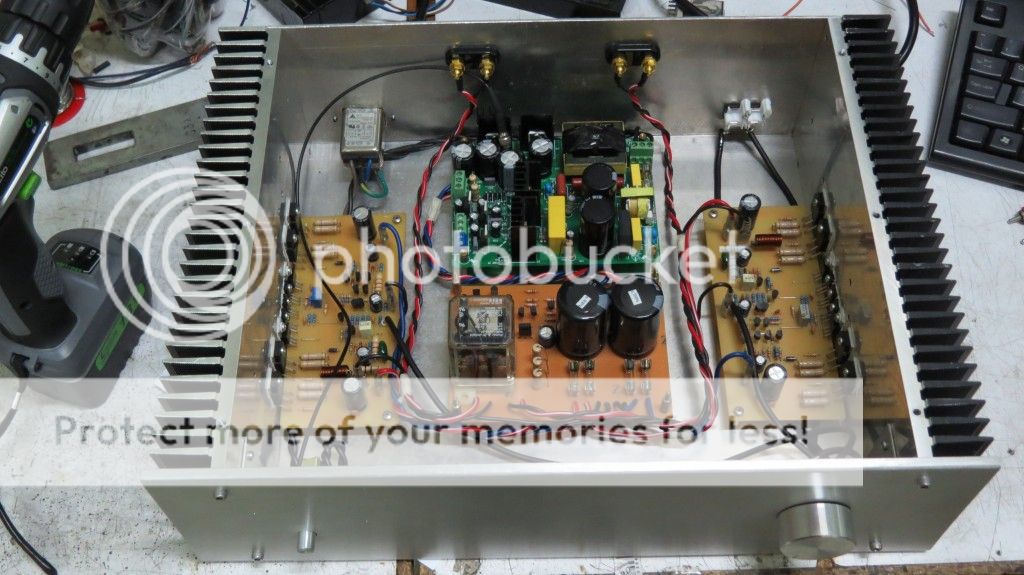



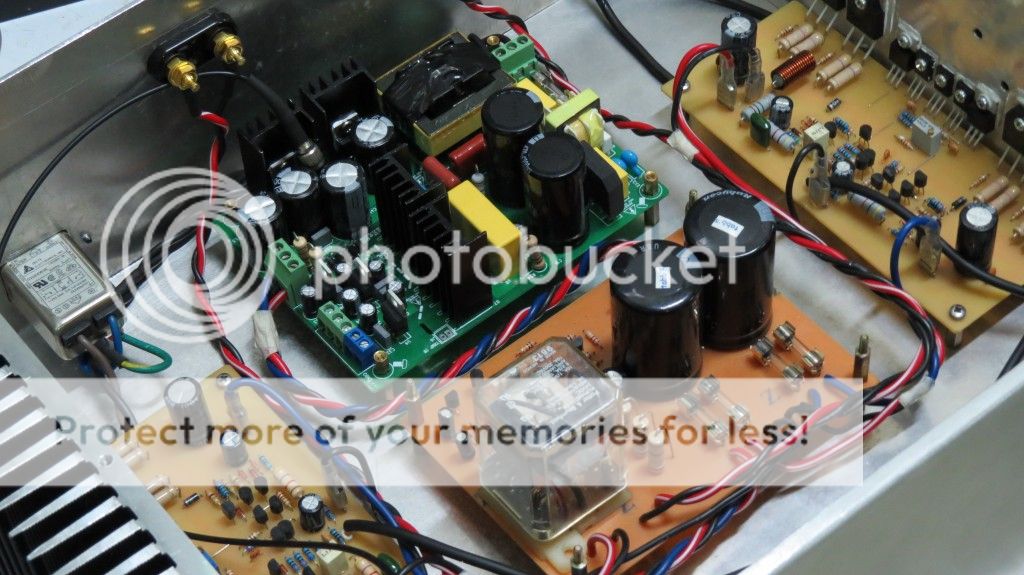
Where you buy SMPS?
How match money?
- Home
- Amplifiers
- Solid State
- SYMEF amplifier
